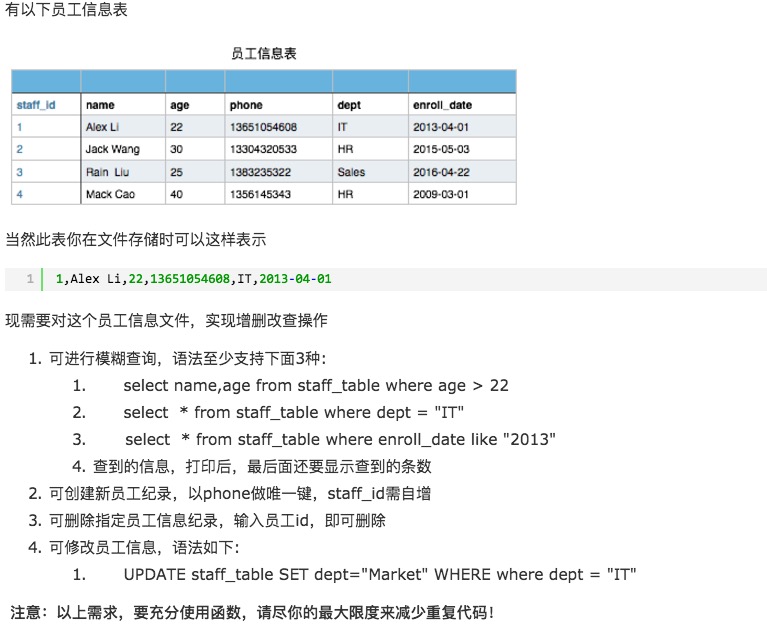python--生成器、三元表达式、列表解析、生成器表达式
2017-06-19 17:07
661 查看
补充:
在文件开头声明一个空字典,然后在每个函数前加上装饰器,完成自动添加到字典的操作
func_dic={}
def make_dic(key):
def deco(func):
func_dic[key] = func
def wrapper(*args, **kwargs):
res = func(*args, **kwargs)
return res
return wrapper
return deco
@make_dic('index') # @deco #f1=deco(f1)
def f1():
print('from f1')
@make_dic('home')
def f2():
print('from f2')
@make_dic('auth')
def f3():
print('from f3')
print(func_dic)
while True:
cmd = input('>>: ').strip()
if cmd in func_dic:
func_dic[cmd]()
结果:
>>: index
from f1
>>: home
from f2
>>: auth
from f3
列表解析
先来两个栗子:
s = 'hello' l = [] for i in s: res = i.upper() l.append(res) print(l) 结果: ['H', 'E', 'L', 'L', 'O']
l = [1, 2, 3, 4] l_new = [] for i in l: res = i**2 l_new.append(res) print(l_new) 结果: [1, 4, 9, 16]
接下来就是我们的列表解析:
s = 'hello' res = [i.upper() for i in s] print(res) 结果: ['H', 'E', 'L', 'L', 'O']
l = [1, 31, 73, 84, 57, 22] res = [i for i in l if i > 50] print(res) 结果: [73, 84, 57]
列表解析的形式:
for i in obj1: if 条件1: for i in obj2: if 条件2: for i in obj3: if 条件3: ...
生成器表达式
g = (i for i in range(100000000000000000000000000000000000000000000000000)) print(g) print(next(g)) #next(g) == g.__next__() print(next(g)) #next(g) == g.__next__() print(next(g)) #next(g) == g.__next__() print(next(g)) #next(g) == g.__next__() print(next(g)) #next(g) == g.__next__() 结果: <generator object <genexpr> at 0x0000000002734990> 0 1 2 3 4
注意:和[i for i in range(1000000000000000000000000000000000000000000)]的区别,有兴趣可以尝试运行此命令。。
len('hello') #'hello'.__len__()
print(len('hello'))
print('hello'.__len__())
结果:
5
5
注意:
相似的原理:iter(g) #g.__iter__()
三元表达式
x = 2 y = 3 if x > y: print(x) else: print(y) res = 'aaaaa' if x > y else 'bbbbbbb' print(res) 结果: 3 bbbbbbb
def max2(x, y): # if x > y: # return x # else: # return y return x if x > y else y print(max2(1, 2)) 结果: 2
生成器函数
函数体内包含有yield关键字,该函数执行的结果是生成器
def foo():
print('first------>')
yield 1
print('second----->')
yield 2
print('third----->')
yield 3
print('fourth----->')
g = foo()
print(g)
from collections import Iterator
print(isinstance(g, Iterator))
结果:
<generator object foo at 0x0000000001E14990>
True
所以我们得到的结果:生成器就是迭代器
def foo():
print('first------>')
yield 1
print('second----->')
yield 2
print('third----->')
yield 3
print('fourth----->')
g = foo()
print(g.__next__())
print(g.__next__())
print(g.__next__())
# print(g.__next__()) #StopInteration
结果:
first------>
1
second----->
2
third----->
3
def foo():
print('first------>')
yield 1
print('second----->')
yield 2
print('third----->')
yield 3
print('fourth----->')
g = foo()
for i in g: #obj=g.__iter__() #obj.__next__()
print(i)
结果:
first------>
1
second----->
2
third----->
3
fourth----->
上两例对比,我们可以看到for 自动捕捉到了StopInteration
总结:
'''
yield的功能:
1.与return类似,都可以返回值,但不一样的地方在于yield返回多次值,而return只能返回一次值
2.为函数封装好了__iter__和__next__方法,把函数的执行结果做成了迭代器
3.遵循迭代器的取值方式obj.__next__(),触发的函数的执行,函数暂停与再继续的状态都是由yield保存的
'''
def countdown(n):
print('starting countdown')
while n > 0:
yield n
n -= 1
print('stop countdown')
g = countdown(5)
print(g)
print(g.__next__())
print(g.__next__())
print(g.__next__())
print(g.__next__())
print(g.__next__())
# print(g.__next__()) #StopInteration
结果:
<generator object countdown at 0x0000000001DF4990>
starting countdown
5
4
3
2
1
同样地,用for可以捕捉StopInteration。
def countdown(n):
print('starting countdown')
while n > 0:
yield n
n -= 1
print('stop countdown')
g = countdown(5)
print(g)
for i in g:
print(i)
结果:
<generator object countdown at 0x0000000002144990>
starting countdown
5
4
3
2
1
stop countdown
应用:tail -f a.txt
import time
def tail(filepath, encoding='utf-8'):
with open(filepath, encoding=encoding) as f:
f.seek(0, 2)
while True:
# f.seek(0, 2) #不行
line = f.readline()
if line:
# print(line,end='')
yield line
else:
time.sleep(0.5)
g = tail('a.txt')
print(g)
print(g.__next__())
结果:
<generator object tail at 0x0000000001E04AF0>
1111111111
或者可以应用for:
for i in g:
print(i)
应用:tail -f a.txt | grep 'error'
import time
def tail(filepath, encoding='utf-8'):
with open(filepath, encoding=encoding) as f:
f.seek(0, 2)
while True:
# f.seek(0, 2) #不行
line = f.readline()
if line:
# print(line,end='')
yield line
else:
time.sleep(0.5)
def grep(lines, pattern):
for line in lines:
if pattern in line:
# print(line)
yield line
tail_g = tail('a.txt')
print(tail_g)
grep_g = grep(tail_g, 'error')
print(grep_g)
print(grep_g.__next__())
结果:
<generator object tail at 0x0000000001E24A98>
<generator object grep at 0x0000000001E24AF0>
qweerror
或者可以应用for:
for i in grep_g:
print(i)
作业:
1 编写 tail -f a.txt |grep 'error' |grep '404'命令,周一默写
2 文件a.txt内容
apple 10 3
tesla 100000 1
mac 3000 2
lenovo 30000 3
chicken 10 3
要求使用列表解析,从文件a.txt中取出每一行,做成下述格式
[{‘name’:'apple','price':10,'count':3},{...},{...},...]
3 格式与2一样,但只保留价格大于1000的商品信息
4 周末大作业(见图):
只实现作业要求的查询功能
增加,删除,修改功能为选做题

答案:
# 1 编写 tail -f a.txt |grep 'error' |grep '404'命令,周一默写
import time
file_path = r'C:\Users\Administrator\PycharmProjects\untitled\a.txt'
def tail(file_path):
with open(file_path, encoding='utf-8') as f:
f.seek(0, 2)
while True:
line = f.readline()
if line:
yield line
else:
time.sleep(0.5)
def grep(lines, pattern):
for line in lines:
if pattern in line:
yield line
g1 = tail('a.txt')
g2 = grep(g1, 'error')
g3 = grep(g2, '404')
for i in g3:
print(i)
# 2 文件a.txt内容
# apple 10 3
# tesla 100000 1
# mac 3000 2
# lenovo 30000 3
# chicken 10 3
#
# 要求使用列表解析,从文件a.txt中取出每一行,做成下述格式
# [{‘name’:'apple','price':10,'count':3},{...},{...},...]
#
# print([{'name': i.split()[0], 'price': i.split()[1], 'count': i.split()[2]} for i in
# open('a.txt')])
print([{'name': i.strip().split()[0], 'price': i.strip().split()[1], 'count': i.strip().split()[2]} for i in
open('a.txt')])
# 3 格式与2一样,但只保留价格大于1000的商品信息
#
print([{'name': i.strip().split()[0], 'price': i.strip().split()[1], 'count': i.strip().split()[2]}for i in
open('a.txt') if i.strip().split()[1] > '1000'])
# 4 周末大作业(见图):
# 只实现作业要求的查询功能
# # 增加,删除,修改功能为选做题
相关文章推荐
- python--迭代器,生成器,三元表达式,列表解析,生成器表达式
- python生成器表达式和列表解析
- Python里有趣的列表解析和生成器表达式
- Python基础:08列表解析与生成器表达式
- 深入理解python的生成器表达式和列表解析
- Python(迭代、三元表达式、列表生成、生成器、迭代器)
- python列表解析和生成器表达式
- Python 生成器函数,生成器表达式,迭代器,列表解析
- Python里有趣的列表解析和生成器表达式
- [转]Python里有趣的列表解析和生成器表达式
- Python开发基础-Day9-生成器、三元表达式、列表生成式、生成器表达式
- python 中的列表解析和生成器表达式
- python生成器表达式和列表解析
- Python 列表解析和生成器表达式
- day21 生成器,列表解析,三元表达式
- 【python】对列表的过滤, 列表解析,生成器表达式
- 三元表达式,列表解析和生成器表达式
- 零基础学python-19.8 生成器表达式:当迭代器遇上列表解析
- Python中的列表解析和生成器表达式
- Python列表解析与生成器表达式
